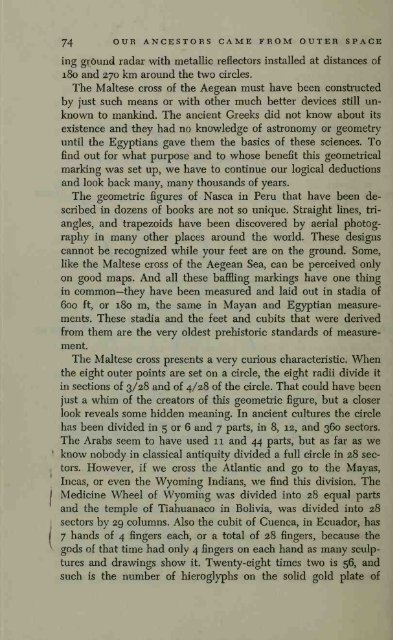You also want an ePaper? Increase the reach of your titles
YUMPU automatically turns print PDFs into web optimized ePapers that Google loves.
74 OUR ANCESTORS CAME FROM OUTER SPACE<br />
ing ground radar with metallic reflectors installed at distances of<br />
180 and 270 km around the two circles.<br />
The Maltese cross of the Aegean must have been constructed<br />
by just such means or with other much better devices still unknown<br />
to mankind. The ancient Greeks did not know about its<br />
existence and they had no knowledge of astronomy or geometry<br />
until the Egyptians gave them the basics of these sciences. To<br />
find out for what purpose and to whose benefit this<br />
geometrical<br />
marking was set up, we have to continue our logical deductions<br />
and look back many, many thousands of years.<br />
The geometric figures of Nasca in Peru that have been described<br />
in dozens of books are not so unique. Straight lines,<br />
triangles,<br />
and trapezoids have been discovered by aerial photography<br />
in many other places around the world. These designs<br />
cannot be recognized while your feet are on the ground.<br />
Some,<br />
like the Maltese cross of the Aegean Sea, can be perceived only<br />
on good maps. And all<br />
these baflfling markings have one thing<br />
in common—they have been measured and laid out in stadia of<br />
600 ft, or 180 m, the same in Mayan and Egyptian measurements.<br />
These stadia and the feet and cubits that were derived<br />
from them are the very oldest prehistoric standards of measmement.<br />
The Maltese cross presents a very curious characteristic. When<br />
the eight outer points are set on a circle, the eight radii divide it<br />
in sections of 3/28 and of 4/28 of the circle. That could have been<br />
just a whim of the creators of this<br />
geometric figure, but a closer<br />
look reveals some hidden meaning. In ancient cultures the circle<br />
has been divided in 5 or 6 and 7 parts, in 8, 12, and 360 sectors.<br />
The Arabs seem to have used 11 and 44 parts, but as far as we<br />
know nobody in classical antiquity divided a full circle in 28 sectors.<br />
However, if we cross the Atlantic and go to the Mayas,<br />
Incas, or even the Wyoming Indians, we find this division. The<br />
Medicine Wheel of Wyoming was divided into 28 equal parts<br />
and the temple of Tiahuanaco in Bolivia, was divided into 28<br />
sectors by 29 columns. Also the cubit of Cuenca, in Ecuador, has<br />
7 hands of 4 fingers each, or a total of 28 fingers, because the<br />
gods of that time had only 4 fingers on each hand as many sculptures<br />
and drawings show it. Twenty-eight times two is 56, and<br />
such is the number of hieroglyphs on the solid gold plate of

















